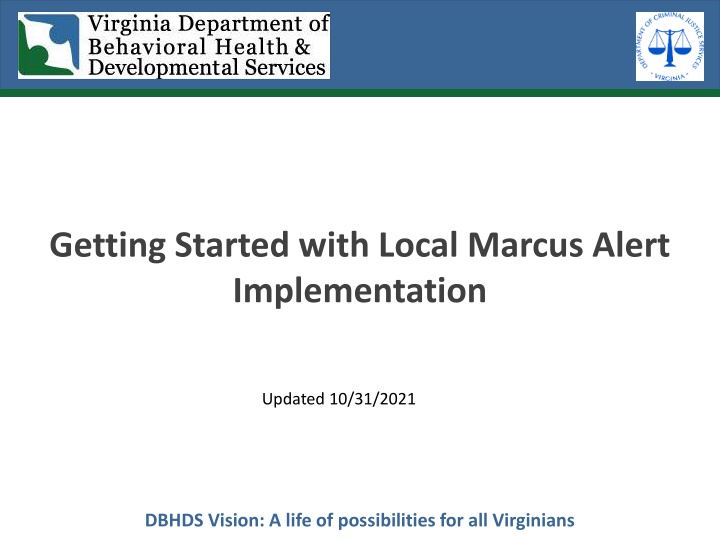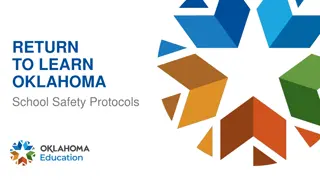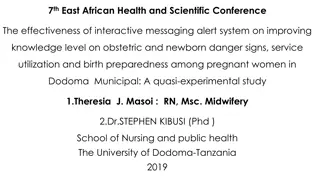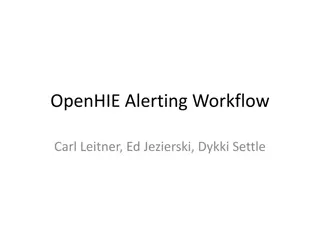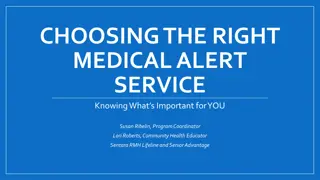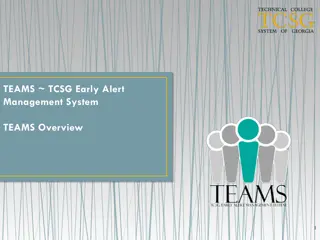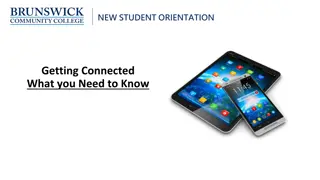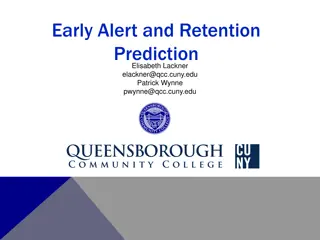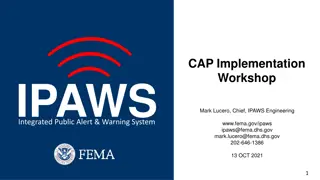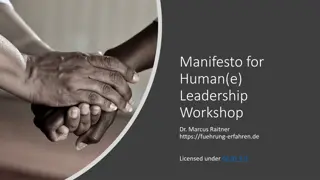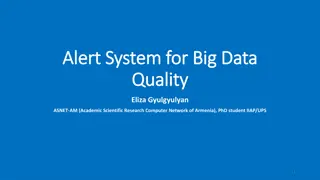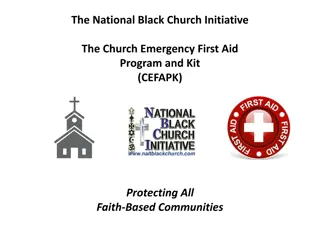Updated Marcus Alert Implementation Overview
This content provides insights into the updated Marcus Alert implementation, including the background, planning process at the state level, state plan overview, and components at the state/regional level. Learn about the significance of state/regional components and why they are essential for effective crisis response systems.
Download Presentation

Please find below an Image/Link to download the presentation.
The content on the website is provided AS IS for your information and personal use only. It may not be sold, licensed, or shared on other websites without obtaining consent from the author.If you encounter any issues during the download, it is possible that the publisher has removed the file from their server.
You are allowed to download the files provided on this website for personal or commercial use, subject to the condition that they are used lawfully. All files are the property of their respective owners.
The content on the website is provided AS IS for your information and personal use only. It may not be sold, licensed, or shared on other websites without obtaining consent from the author.
E N D
Presentation Transcript
Getting Started with Local Marcus Alert Implementation Updated 10/31/2021 DBHDS Vision: A life of possibilities for all Virginians
Background of Marcus-David Peters Act Named in honor of Marcus-David Peters, a young Black biology teacher was shot and killed by police in the midst of a mental health crisis Passed during a Special Session in 2020 Aims to provide a community based, behavioral health response to behavioral health crises Slide 2
Planning Process at State Level The first requirement of the Act was for DBHDS, with DCJS and stakeholders, to develop a plan for developing a Marcus alert system by July 1, 2021 The state plan includes a plan for the statewide and regional components, and also provides a framework for localities to plan and implement the local requirements of the Marcus Alert example flyer from a statewide listening session For more info: www.dbhds.virginia.gov/marcusalert The state plan can be found here Slide 3
State Plan Overview 5 State or Regional Components 8 Local Components Slide 4
5 State/Regional Components STEP-VA 4 level framework for urgency Equity at Intercept 0 Initiative Mobile Crisis Teams And BRAVO Medicaid rates Public Service Announcements and Marketing focused on dialing 9-8-8 as of July 1, 2022 Statewide Training Standards and Supports Slide 5
Why are these components at the state/regional level? Urgency Triage The urgency triage is at the state level so that we have a common way to communicate across areas regarding the different urgency levels of situations. This is important for understanding what teams are sent to what situations and patterns over time. STEP-VA Teams and Medicaid Rates STEP-VA Mobile Crisis Teams are at the regional level for the economy of scale. This way teams can be co-located throughout the region but respond when they are the closest team, even if it is outside the specific local area. The Medicaid rates are statewide because they are being added to the state Medicaid plan. Equity at Intercept 0 The Equity at Intercept 0 is managed at the state level and funded with a federal grant. The project supports a statewide Black-led coalition as well as regional and local projects that are peer led and/or BIPOC led. Projects are coordinated with state entities, academic institutions, and/or regional mobile crisis hubs or other crisis supports. Training standards are at the state level so that they can be integrated into the broader training infrastructure in the different areas. For example, DCJS manages the state expectations for law enforcement regional training academies, and sets the requirements for basic and inservice police training. On the behavioral health side, standard curriculums are under development to ensure consistent services across the state. Training Standards 988 advertising and awareness Awareness campaign focuses on identification during the early signs of a crisis and connecting to resources through the use off the three digit code 9-8-8. There is an associated federal campaign and state materials will be designed to be recognizable across the state. They can then be further tailored at the local level, but the campaign development and materials are a state component. Slide 6
This guide to getting started is focused on introducing the 8 local components. Slide 7
8 Local Components Local Planning Group and Process Local PSAP CAD integrate the 4 level urgency framework Protocol #1 (911 988 transfer) Voluntary Database CAD Community Coverage Options and Plans Protocol #2 (agreement with crisis call center) Protocol #3 Plan Submission (Law Enforcement Policies and Protocols) (phased in date) Plan Submission Slide 8
Who is responsible for local implementation? Local Component Voluntary Database Responsible Entity Local government; 911 center Local planning group and process Local government responsible for ensuring it happens. It is recommended that the responsibility is delegated to the CSB (e.g., ES director) or CIT coordinator Using the 4 level urgency framework 911 center is responsible for integrating the state 4-level framework for urgency into standard operating procedure Local Protocol #1 Local Protocol #2 Local Protocol #3 Plan for community coverage Submitting plan & data 911 center, to be coordinated with regional 988 call center Law enforcement agency, to be coordinated with regional 988 call center Law enforcement agency Shared responsibility, Local stakeholder group lead facilitates Local government responsible for ensuring it happens. Delegating to local stakeholder group lead recommended. The responsibility to report quarterly falls to the local government. Resources will likely be needed by whichever entity this is delegated to once more details are available Slide 9
Local Component 1: Voluntary Database F. By July 1, 2021, every locality shall establish a voluntary database to be made available to the 9-1-1 alert system and the Marcus alert system to provide relevant mental health information and emergency contact information for appropriate response to an emergency or crisis. Identifying and health information concerning behavioral health illness, mental health illness, developmental or intellectual disability, or brain injury may be voluntarily provided to the database by the individual with the behavioral health illness, mental health illness, developmental or intellectual disability, or brain injury; the parent or legal guardian of such individual if the individual is under the age of 18; or a person appointed the guardian of such person as defined in 64.2- 2000. An individual shall be removed from the database when he reaches the age of 18, unless he or his guardian, as defined in 64.2-2000, requests that the individual remain in the database. Information provided to the database shall not be used for any other purpose except as set forth in this subsection. Slide 10
Local Component 1: Voluntary Database Earliest local requirement of the Act (July, 2021) Under purview of DCJS because of oversight of PSAP training/law enforcement dispatch The what is specified: Voluntary, info used for this purpose only Used by 911/emergency response system Community members can provide information they want available Youth included by their guardians shall be removed at age of 18 unless they consent The how is not specified: Localities can build this function into existing processes, databases, etc. For example, hazard lists Localities can build a new database using minimal technology and existing resources, ensuring there is a process for individuals to provide their information Localities can use third party tools such as Smart 911 or Rave 911 Slide 11
Local Component 2: Local Planning Group and Process Local planning can begin anytime after the release of the state plan (July, 2021) It is recommended that local planning begin no later than November, 2021 Slide 12
Local Component 2: Local Planning Group and Process There are 5 stages of the local planning process There is a Community Roadmap available to guide areas through the planning process If areas have recently leveraged other planning processes (e.g., Sequential Intercept Mapping, Diversion First), the results from these processes can be used to meet overlapping requirements of the 5 stages Slide 13
Local Component 2: Local Planning Group and Process The Community Roadmap document starts at the very beginning, which focuses on identifying the geographical bounds of the implementing area and starting to form a local stakeholder group A stakeholder group convener needs to be identified. CSB Emergency Services or CIT Coordinator is recommended Existing coalitions such as safety net coalitions can be delegated to lead implementation, as long as they are able to meet the requirements of the planning process Slide 14
Other Local Components (#3-8) All other local components will be developed throughout the planning process once it has been initiated General overviews of each component (#3-8) are provided here for informational purposes Slide 15
Local Component 3: Adopting the 4-level urgency framework It is required that the 4 level urgency framework be introduced to the CAD system, as the 4 levels are the framework for guiding the local responses developed This is required July 1, 2022, because that is when the 3 protocols are required statewide Communication in terms of the 4 urgency levels begins July 1, 2022 even if you have not yet received funding or a deadline to implement full community coverage. It is the guiding framework for the protocols. Slide 16
Local Component 3: Adopting the 4-level urgency framework PSAPs across the state use different standardized, national, or homegrown CAD systems To implement Marcus Alert, the task is to integrate these urgency levels into your existing system The urgency level does not replace the call type in your CAD A statewide training is being developed, but ensuring staff are able to classify events beginning July 1, 2022 will require some interim local training and coordination Slide 17
Local Component 4: Protocol #1 Protocol #1 refers to a protocol to transfer and coordinate 9-1-1 calls related to mental health crisis to the regional 9-8-8 call center Protocol #1 is required at level 1 and recommended for level 2 Protocol #1 may also be appropriate for level 3 situations, depending on the travel time required by mobile crisis and other factors such as the need for a specialized children s mobile crisis response or specialized response for individuals with developmental disabilities Protocol #1 refers to the range of policies, standard operating procedures, and agreements that, together, ensure there is a way for 9-1-1 call takers to connect individuals experiencing a behavioral health crisis to the 9-8-8 call centers for assessment and mobile crisis response Slide 18
Local Component 5: Protocol #2 Protocol #2 refers to a memorandum of agreement or other contract between the regional 9-8-8 call center and/or regional mobile crisis hub and local law enforcement agencies This protocol outlines the responsibilities and agreements if a mobile crisis team requests law enforcement back up (in person, securing the scene, or at a distance) for a mobile crisis response Slide 19
Local Component 6: Protocol #3 Protocol #3 refers to the law enforcement policies and procedures that apply whenever law enforcement is responding to a Marcus Alert situation This does not only include responses such as serving as back up or as part of a co-response, it also includes general policies that apply whether or not a mobile crisis team is involved It requires law enforcement to describe their approach to meeting the 17 Law Enforcement goals of the Marcus-David Peters Act. The state plan requests information in these 4 domains: System-level and leadership level (includes agency level culture and policies) Basic training (training that applies to all officers) Intermediate training (training for officers with interest and aptitude, such as CIT) Advanced training (training for officers who are part of a specialized response) Slide 20
Local Component 6: Protocol #3 The framework for developing Protocol #3 is depicted below. The systems approach taken for Protocol #3 means that it is not a single policy but an overall strategy and collection of policies at each level. Slide 21
Local Component #7: Plan for Community Coverage As STEP-VA/BRAVO mobile crisis teams will provide statewide coverage, each locality is not required to form distinct, Marcus Alert teams Local plans should outline the community coverage at each Urgency level In other words, the plan for community coverage demonstrates which protocols and teams will be considered for dispatch at each urgency level Includes coordination with the mobile crisis system as well as protocols for law enforcement only responses Slide 22
Local Component #7: Plan for Community Coverage Next are some three examples of how a community might plan to provide coverage at each urgency level Although the definitions for what is considered a level 1, 2, 3, and 4 are standard at the state level, the community coverage plan is localized There are a number of standard requirements, but also a number of decision points and options for structures and teams A community s plan might look one way July 1, 2022, when only the protocols are required to be in place The plan might look different or have additional supports when the area is phased in and community coverage is required Slide 23
Community Coverage = Your Plan for Levels 1,2,3,and 4 INVOLVE BEHAVIORAL HEALTH AS SOON AS POSSIBLE BEHAVIORAL HEALTH REMOTE ENGAGEMENT DURING TRANSIT IF POSSIBLE ASSESS NEED FOR MEDICAL RESPONSE LEVEL 1 RESPONSE LEVEL 4 RESPONSE LEVEL 2 RESPONSE LEVEL 3 RESPONSE 911 PSAPs refer to 988 regional call centers 911 PSAPs dispatch law enforcement, EMS, and/or fire without delay Poison Control Model, to include staying on the phone during the clinical assessment until 9-8-8 makes response determination 9-1-1 staff can leave phone call when it is determined that the initial behavioral health intervention will be remote (e.g., phone, telehealth), because this may be 30 minutes plus If 9-8-8 is dispatching mobile crisis, share information for any potential need for LE back up; can then leave phone call Telehealth-based relationship between CIT officers, CIT trained EMS, and mobile crisis hub or another crisis provider. LE makes remote contact and is dispatched to scene, without any sirens or lights. Depending on telehealth capabilities, mobile crisis (STEP-VA) could also be requested simultaneously. LE assesses the scene, remains engaged with the telehealth provider while engaging the individual, and the team collaborates on next steps. All PSAPs have procedure and specification to transfer calls to regional call center in our area, and document the transfer as the call disposition. All first responders trained in local Marcus Alert specialized response protocols. Shift coverage with CIT officers as well as officers who have received Advanced MA training, and these officers and EMS who have received advanced MA training are dispatched preferentially. Local specialized response protocol (#3) includes linking to all components of response for Level 3 when scene is safe for intervention. Slide 24
INVOLVE BEHAVIORAL HEALTH AS SOON AS POSSIBLE BEHAVIORAL HEALTH REMOTE ENGAGEMENT DURING TRANSIT IF POSSIBLE ASSESS NEED FOR MEDICAL RESPONSE LEVEL 1 RESPONSE LEVEL 4 RESPONSE LEVEL 2 RESPONSE LEVEL 3 RESPONSE 911 PSAPs dispatch law enforcement, EMS, and/or fire without delay All first responders trained in local Marcus Alert specialized response protocols. Shift coverage with CIT officers as well as officers who have received Advanced MA training, and these officers and EMS who have received advanced MA training are dispatched preferentially. Mobile crisis (local 30 minute response goal) dispatched simultaneously but kept continually informed in transit and does not arrive or approach scene until considered safe and appropriate to do so by LE and EMS. 911 PSAPs refer to 988 regional call centers Mobile crisis response, utilizing local teams for preferred customer response (e.g., local goal may be 30 minute response). Remote engagement in transit, including sharing any information about who will arrive, when, and for what type of support. LE aware of location and call (if very close by) or dispatched simultaneously to serve in back up capacity or secure the safety of the scene prior to the mobile crisis team beginning their intervention. CIT officers with advanced training always dispatched preferentially (local goal= 100% of the time). LE may be asked to remain on the scene or released. Mobile crisis response, using modified Poison Control Model, to include staying on the phone during the clinical assessment until 9-8-8 makes response determination (particularly focused on whether mobile crisis is recommended for dispatch). 9-8-8 dispatches mobile crisis utilizing local or regional teams (all under MOU with hub), 9-1-1 monitors/flags so that information gathered initially is provided to any calls for back up law enforcement involvement later in the situation. All PSAPs have procedure and specification to transfer calls to regional call center in our area, and document the transfer as the call disposition. Slide 25
INVOLVE BEHAVIORAL HEALTH AS SOON AS POSSIBLE BEHAVIORAL HEALTH REMOTE ENGAGEMENT DURING TRANSIT IF POSSIBLE ASSESS NEED FOR MEDICAL RESPONSE LEVEL 1 RESPONSE LEVEL 4 RESPONSE LEVEL 2 RESPONSE LEVEL 3 RESPONSE 911 PSAPs dispatch law enforcement, EMS, and/or fire without delay All first responders trained in local Marcus Alert specialized response protocols. Community care teams and mobile crisis considered second responders. Shift coverage with CIT officers as well as officers who have received Advanced MA training, and these officers and EMS who have received advanced MA training are dispatched preferentially. Community care or Mobile crisis team may be dispatched simultaneously, if so, kept continually informed in transit and do not arrive or approach scene until considered safe and appropriate to do so by LE and EMS. 911 PSAPs refer to 988 regional call centers Community care team response utilizing a CAHOOTS style two person team (EMS/Peer, Peer/QMHP, etc.) respond to the scene. Coordination with 9-8-8 as needed to determine next steps (e.g., transport to crisis receiving center, connect to clinician). LE aware of location and prepared to serve as back up as needed. CIT officers with advanced training always dispatched preferentially (local goal= 100% of the time). LE may be asked to remain on the scene or released. Goal is to connect the individual to the correct level of care on crisis continuum as quickly as possible. Team also does brief follow ups after encounters for preventive support. Mobile crisis response, using modified Poison Control Model, to include staying on the phone during the clinical assessment until 9-8-8 makes response determination (particularly focused on whether mobile crisis is recommended for dispatch). Depending on the situation and availability, a dispatch of regional mobile crisis or local community care team will be used. 9-1-1 monitors/flags so that information gathered initially is provided to any calls for back up law enforcement involvement later in the situation. All PSAPs have procedure and specification to transfer calls to regional call center in our area, and document the transfer as the call disposition. Slide 26
Local Component #8: Submitting a Plan and Data Local plans for July 1, 2022 need to be submitted by mid-May to be reviewed prior to the required implementation date A web portal for submission will be made available The submission has 11 components Most data will come from the crisis call center data platform, but quarterly data is also required from PSAPs to gather basic information about Marcus Alert calls and the dispatch disposition Technical specifications are still under development and will be provided with time for testing prior to July 1, 2022 requirement Slide 27
Local Component #8: Submitting a Plan and Data DBHDS and DCJS both review, approve, or conditionally approve and provide technical assistance to the different plan components Response will be within 4-6 weeks Slide 28
Local Component #8: Submitting a Plan and Data Summary of local planning process, including documentation of key areas defined in the roadmap ( Decide and Document components) List of stakeholder group members Crosswalk showing how the 4 urgency levels are defined in your CAD system and/or triage cards Copy of Protocol #1 Copy of Protocol #2 Copy of Protocol #3 Crosswalk showing the community coverage and protocols used at each of the 4 urgency levels Checklist of minimum standards and best practices for law enforcement involvement Statement on accountability for quarterly cross sector meetings and quarterly data reporting Contact information for application overall as well as contacts for each sector (e.g., PSAPs, law enforcement) This is a brief overview of the 11 documents or information that need to be submitted for review. Slide 29
Please visit the Marcus Alert website to access the toolkit materials referenced in this slideshow. https://www.dbhds.Virginia.gov/marcusalert Slide 30
Implementation Support There is a Marcus Alert regional coordinator for each DBHDS region. They are currently working with initial areas but will be a resource you can use for regional technical assistance soon. Currently, questions, comments, or requests for local presentations or technical assistance can be send to: Marcusalert@dbhds.Virginia.gov Slide 31
